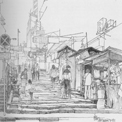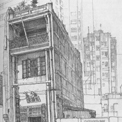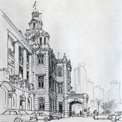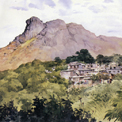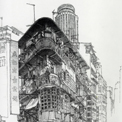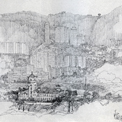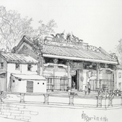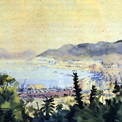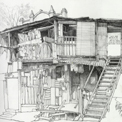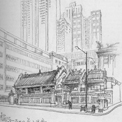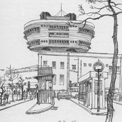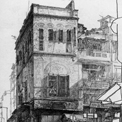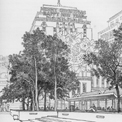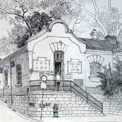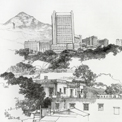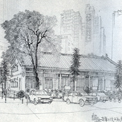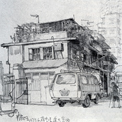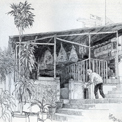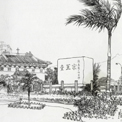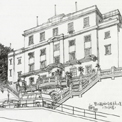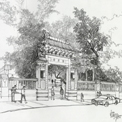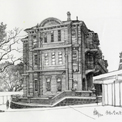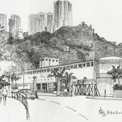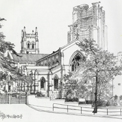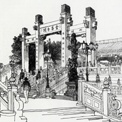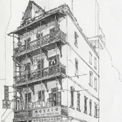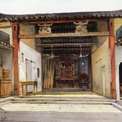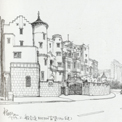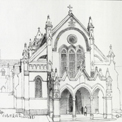Hung Shing Temple, Ap Lei Chau
Hung Shing was a native of Nanhai in Guangdong in the late Tang Dynasty. He was later revered by fishermen as the God of the Seas. Where there are fishermen, there is usually a Hung Shing Temple. The Hung Shing Temple in Ap Lei Chau was built in 1773. After the British took over Hong Kong, a police station was built on the opposite side in Aberdeen, so two flagstaffs were added to shelter the temple from bad luck.
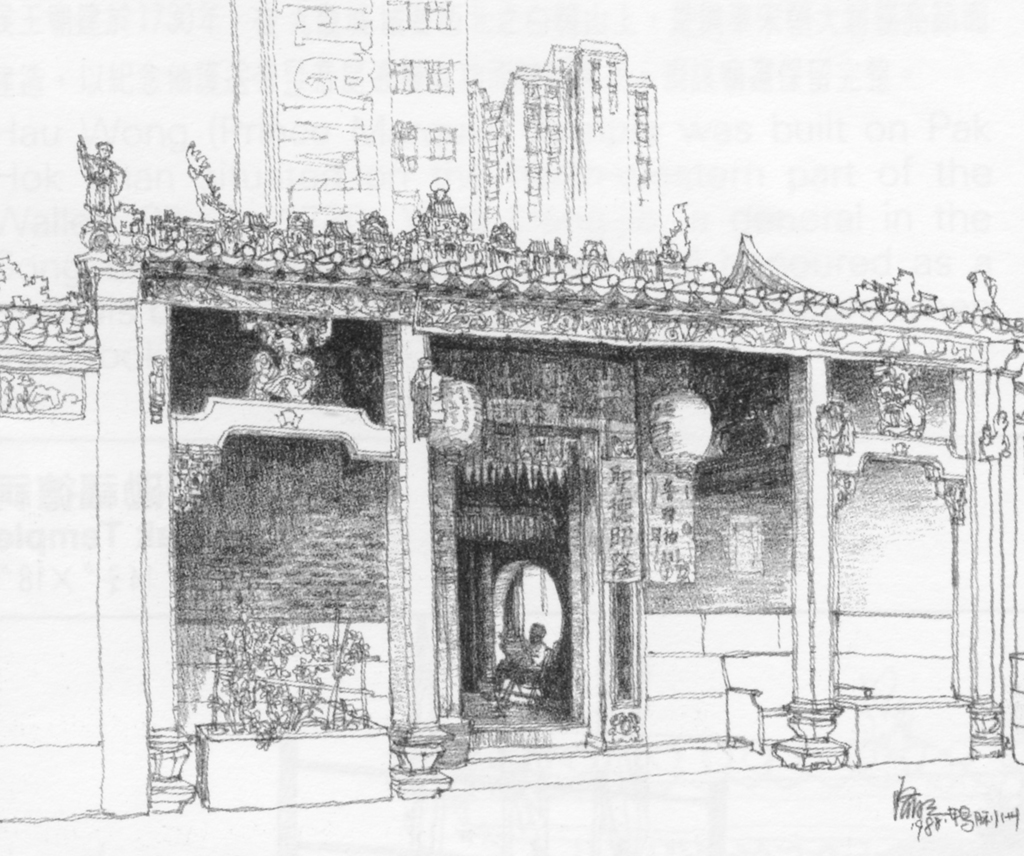
| Date | 1988 |
| Place | Hong Kong Island/Southern District/Ap Lei Chau/(Street)/Hung Shing Temple |
| people | Kong Kai Ming |
| Material Type | Image |
| Collection | Sketches by Kong Kai-ming |
| Source | Kong, Kai Ming. Landmarks of Hong Kong: Further Artistic Impression. (Hong Kong: The School of Continuing Education, Hong Kong Baptist University, 1994), p.183 |
| Repository | The University of Hong Kong Libraries |
| Note to Copyright | Permission for use is given by Kong Kai Ming |
| Accession No. | LA005-327 |
Hung Shing Temple, Ap Lei Chau
Hung Shing was a native of Nanhai in Guangdong in the late Tang Dynasty. He was later revered by fishermen as the God of the Seas. Where there are fishermen, there is usually a Hung Shing Temple. The Hung Shing Temple in Ap Lei Chau was built in 1773. After the British took over Hong Kong, a police station was built on the opposite side in Aberdeen, so two flagstaffs were added to shelter the temple from bad luck.
| Date | 1988 |
| Place | Hong Kong Island/Southern District/Ap Lei Chau/(Street)/Hung Shing Temple |
| People | Kong Kai Ming |
| Material Type | Image |
| Collection | Sketches by Kong Kai-ming |
| Source | Kong, Kai Ming. Landmarks of Hong Kong: Further Artistic Impression. (Hong Kong: The School of Continuing Education, Hong Kong Baptist University, 1994), p.183 |
| Repository | The University of Hong Kong Libraries |
| Note to Copyright | Permission for use is given by Kong Kai Ming |
| Accession No. | LA005-327 |
Hung Shing Temple, Ap Lei Chau
Hung Shing was a native of Nanhai in Guangdong in the late Tang Dynasty. He was later revered by fishermen as the God of the Seas. Where there are fishermen, there is usually a Hung Shing Temple. The Hung Shing Temple in Ap Lei Chau was built in 1773. After the British took over Hong Kong, a police station was built on the opposite side in Aberdeen, so two flagstaffs were added to shelter the temple from bad luck.
| Date | 1988 |
| Place | Hong Kong Island/Southern District/Ap Lei Chau/(Street)/Hung Shing Temple |
| People | Kong Kai Ming |
| Material Type | Image |
| Collection | Sketches by Kong Kai-ming |
| Source | Kong, Kai Ming. Landmarks of Hong Kong: Further Artistic Impression. (Hong Kong: The School of Continuing Education, Hong Kong Baptist University, 1994), p.183 |
| Repository | The University of Hong Kong Libraries |
| Note to Copyright | Permission for use is given by Kong Kai Ming |
| Accession No. | LA005-327 |
Hung Shing Temple, Ap Lei Chau
Hung Shing was a native of Nanhai in Guangdong in the late Tang Dynasty. He was later revered by fishermen as the God of the Seas. Where there are fishermen, there is usually a Hung Shing Temple. The Hung Shing Temple in Ap Lei Chau was built in 1773. After the British took over Hong Kong, a police station was built on the opposite side in Aberdeen, so two flagstaffs were added to shelter the temple from bad luck.
| Date | 1988 |
| Place | Hong Kong Island/Southern District/Ap Lei Chau/(Street)/Hung Shing Temple |
| People | Kong Kai Ming |
| Material Type | Image |
| Collection | Sketches by Kong Kai-ming |
| Source | Kong, Kai Ming. Landmarks of Hong Kong: Further Artistic Impression. (Hong Kong: The School of Continuing Education, Hong Kong Baptist University, 1994), p.183 |
| Repository | The University of Hong Kong Libraries |
| Note to Copyright | Permission for use is given by Kong Kai Ming |
| Accession No. | LA005-327 |
Hung Shing Temple, Ap Lei Chau
Hung Shing was a native of Nanhai in Guangdong in the late Tang Dynasty. He was later revered by fishermen as the God of the Seas. Where there are fishermen, there is usually a Hung Shing Temple. The Hung Shing Temple in Ap Lei Chau was built in 1773. After the British took over Hong Kong, a police station was built on the opposite side in Aberdeen, so two flagstaffs were added to shelter the temple from bad luck.
| Date | 1988 |
| People | Kong Kai Ming |
| Material Type | Image |
| Collection | Sketches by Kong Kai-ming |
| Source | Kong, Kai Ming. Landmarks of Hong Kong: Further Artistic Impression. (Hong Kong: The School of Continuing Education, Hong Kong Baptist University, 1994), p.183 |
| Repository | The University of Hong Kong Libraries |
| Note to Copyright | Permission for use is given by Kong Kai Ming |
| Accession No. | LA005-327 |
Hung Shing Temple, Ap Lei Chau
Hung Shing was a native of Nanhai in Guangdong in the late Tang Dynasty. He was later revered by fishermen as the God of the Seas. Where there are fishermen, there is usually a Hung Shing Temple. The Hung Shing Temple in Ap Lei Chau was built in 1773. After the British took over Hong Kong, a police station was built on the opposite side in Aberdeen, so two flagstaffs were added to shelter the temple from bad luck.
| Date | 1988 |
| Place | Hong Kong Island/Southern District/Ap Lei Chau/(Street)/Hung Shing Temple |
| People | Kong Kai Ming |
| Material Type | Image |
| Collection | Sketches by Kong Kai-ming |
| Source | Kong, Kai Ming. Landmarks of Hong Kong: Further Artistic Impression. (Hong Kong: The School of Continuing Education, Hong Kong Baptist University, 1994), p.183 |
| Repository | The University of Hong Kong Libraries |
| Note to Copyright | Permission for use is given by Kong Kai Ming |
| Accession No. | LA005-327 |
Hung Shing Temple, Ap Lei Chau
Hung Shing was a native of Nanhai in Guangdong in the late Tang Dynasty. He was later revered by fishermen as the God of the Seas. Where there are fishermen, there is usually a Hung Shing Temple. The Hung Shing Temple in Ap Lei Chau was built in 1773. After the British took over Hong Kong, a police station was built on the opposite side in Aberdeen, so two flagstaffs were added to shelter the temple from bad luck.
| Date | 1988 |
| Place | Hong Kong Island/Southern District/Ap Lei Chau/(Street)/Hung Shing Temple |
| People | Kong Kai Ming |
| Material Type | Image |
| Collection | Sketches by Kong Kai-ming |
| Source | Kong, Kai Ming. Landmarks of Hong Kong: Further Artistic Impression. (Hong Kong: The School of Continuing Education, Hong Kong Baptist University, 1994), p.183 |
| Repository | The University of Hong Kong Libraries |
| Note to Copyright | Permission for use is given by Kong Kai Ming |
| Accession No. | LA005-327 |
Hung Shing Temple, Ap Lei Chau
Hung Shing was a native of Nanhai in Guangdong in the late Tang Dynasty. He was later revered by fishermen as the God of the Seas. Where there are fishermen, there is usually a Hung Shing Temple. The Hung Shing Temple in Ap Lei Chau was built in 1773. After the British took over Hong Kong, a police station was built on the opposite side in Aberdeen, so two flagstaffs were added to shelter the temple from bad luck.
| Date of Death | 1988 |
| Place | Hong Kong Island/Southern District/Ap Lei Chau/(Street)/Hung Shing Temple |
| People | Kong Kai Ming |
| Material Type | Image |
| Collection | Sketches by Kong Kai-ming |
| Source | Kong, Kai Ming. Landmarks of Hong Kong: Further Artistic Impression. (Hong Kong: The School of Continuing Education, Hong Kong Baptist University, 1994), p.183 |
| Repository | The University of Hong Kong Libraries |
| Note to Copyright | Permission for use is given by Kong Kai Ming |
| Accession No. | LA005-327 |
Hung Shing Temple, Ap Lei Chau
Hung Shing was a native of Nanhai in Guangdong in the late Tang Dynasty. He was later revered by fishermen as the God of the Seas. Where there are fishermen, there is usually a Hung Shing Temple. The Hung Shing Temple in Ap Lei Chau was built in 1773. After the British took over Hong Kong, a police station was built on the opposite side in Aberdeen, so two flagstaffs were added to shelter the temple from bad luck.
| Date | 1988 |
| Material Type | Image |
| Collection | Sketches by Kong Kai-ming |
| Source | Kong, Kai Ming. Landmarks of Hong Kong: Further Artistic Impression. (Hong Kong: The School of Continuing Education, Hong Kong Baptist University, 1994), p.183 |
| Note to Copyright | Permission for use is given by Kong Kai Ming |
| Accession No. | LA005-327 |
Hung Shing Temple, Ap Lei Chau
Hung Shing was a native of Nanhai in Guangdong in the late Tang Dynasty. He was later revered by fishermen as the God of the Seas. Where there are fishermen, there is usually a Hung Shing Temple. The Hung Shing Temple in Ap Lei Chau was built in 1773. After the British took over Hong Kong, a police station was built on the opposite side in Aberdeen, so two flagstaffs were added to shelter the temple from bad luck.
| Date | 1988 |
| Material Type | Image |
| Place | Hong Kong Island/Southern District/Ap Lei Chau/(Street)/Hung Shing Temple |
| People | Kong Kai Ming |
| Collection | Sketches by Kong Kai-ming |
| Source | Kong, Kai Ming. Landmarks of Hong Kong: Further Artistic Impression. (Hong Kong: The School of Continuing Education, Hong Kong Baptist University, 1994), p.183 |
| Repository | The University of Hong Kong Libraries |
| Note to Copyright | Permission for use is given by Kong Kai Ming |
| Accession No. | LA005-327 |
Hung Shing Temple, Ap Lei Chau
Hung Shing was a native of Nanhai in Guangdong in the late Tang Dynasty. He was later revered by fishermen as the God of the Seas. Where there are fishermen, there is usually a Hung Shing Temple. The Hung Shing Temple in Ap Lei Chau was built in 1773. After the British took over Hong Kong, a police station was built on the opposite side in Aberdeen, so two flagstaffs were added to shelter the temple from bad luck.
| Date | 1988 |
| Place | Hong Kong Island/Southern District/Ap Lei Chau/(Street)/Hung Shing Temple |
| People | Kong Kai Ming |
| Material Type | Image |
| Collection | Sketches by Kong Kai-ming |
| Source | Kong, Kai Ming. Landmarks of Hong Kong: Further Artistic Impression. (Hong Kong: The School of Continuing Education, Hong Kong Baptist University, 1994), p.183 |
| Repository | The University of Hong Kong Libraries |
| Note to Copyright | Permission for use is given by Kong Kai Ming |
| Accession No. | LA005-327 |
Hung Shing Temple, Ap Lei Chau
Hung Shing was a native of Nanhai in Guangdong in the late Tang Dynasty. He was later revered by fishermen as the God of the Seas. Where there are fishermen, there is usually a Hung Shing Temple. The Hung Shing Temple in Ap Lei Chau was built in 1773. After the British took over Hong Kong, a police station was built on the opposite side in Aberdeen, so two flagstaffs were added to shelter the temple from bad luck.
| Date | 1988 |
| Place | Hong Kong Island/Southern District/Ap Lei Chau/(Street)/Hung Shing Temple |
| People | Kong Kai Ming |
| Material Type | Image |
| Collection | Sketches by Kong Kai-ming |
| Source | Kong, Kai Ming. Landmarks of Hong Kong: Further Artistic Impression. (Hong Kong: The School of Continuing Education, Hong Kong Baptist University, 1994), p.183 |
| Repository | The University of Hong Kong Libraries |
| Note to Copyright | Permission for use is given by Kong Kai Ming |
| Accession No. | LA005-327 |
Hung Shing Temple, Ap Lei Chau
Hung Shing was a native of Nanhai in Guangdong in the late Tang Dynasty. He was later revered by fishermen as the God of the Seas. Where there are fishermen, there is usually a Hung Shing Temple. The Hung Shing Temple in Ap Lei Chau was built in 1773. After the British took over Hong Kong, a police station was built on the opposite side in Aberdeen, so two flagstaffs were added to shelter the temple from bad luck.
| Date | 1988 |
| Place | Hong Kong Island/Southern District/Ap Lei Chau/(Street)/Hung Shing Temple |
| People | Kong Kai Ming |
| Material Type | Image |
| Collection | Sketches by Kong Kai-ming |
| Source | Kong, Kai Ming. Landmarks of Hong Kong: Further Artistic Impression. (Hong Kong: The School of Continuing Education, Hong Kong Baptist University, 1994), p.183 |
| Repository | The University of Hong Kong Libraries |
| Note to Copyright | Permission for use is given by Kong Kai Ming |
| Accession No. | LA005-327 |
Hung Shing Temple, Ap Lei Chau
Hung Shing was a native of Nanhai in Guangdong in the late Tang Dynasty. He was later revered by fishermen as the God of the Seas. Where there are fishermen, there is usually a Hung Shing Temple. The Hung Shing Temple in Ap Lei Chau was built in 1773. After the British took over Hong Kong, a police station was built on the opposite side in Aberdeen, so two flagstaffs were added to shelter the temple from bad luck.
| Date | 1988 |
| Place | Hong Kong Island/Southern District/Ap Lei Chau/(Street)/Hung Shing Temple |
| People | Kong Kai Ming |
| Material Type | Image |
| Collection | Sketches by Kong Kai-ming |
| Source | Kong, Kai Ming. Landmarks of Hong Kong: Further Artistic Impression. (Hong Kong: The School of Continuing Education, Hong Kong Baptist University, 1994), p.183 |
| Repository | The University of Hong Kong Libraries |
| Note to Copyright | Permission for use is given by Kong Kai Ming |
| Accession No. | LA005-327 |
Hung Shing Temple, Ap Lei Chau
Hung Shing was a native of Nanhai in Guangdong in the late Tang Dynasty. He was later revered by fishermen as the God of the Seas. Where there are fishermen, there is usually a Hung Shing Temple. The Hung Shing Temple in Ap Lei Chau was built in 1773. After the British took over Hong Kong, a police station was built on the opposite side in Aberdeen, so two flagstaffs were added to shelter the temple from bad luck.
| Date | 1988 |
| Place | Hong Kong Island/Southern District/Ap Lei Chau/(Street)/Hung Shing Temple |
| People | Kong Kai Ming |
| Material Type | Image |
| Collection | Sketches by Kong Kai-ming |
| Source | Kong, Kai Ming. Landmarks of Hong Kong: Further Artistic Impression. (Hong Kong: The School of Continuing Education, Hong Kong Baptist University, 1994), p.183 |
| Repository | The University of Hong Kong Libraries |
| Note to Copyright | Permission for use is given by Kong Kai Ming |
| Accession No. | LA005-327 |
Hung Shing Temple, Ap Lei Chau
Hung Shing was a native of Nanhai in Guangdong in the late Tang Dynasty. He was later revered by fishermen as the God of the Seas. Where there are fishermen, there is usually a Hung Shing Temple. The Hung Shing Temple in Ap Lei Chau was built in 1773. After the British took over Hong Kong, a police station was built on the opposite side in Aberdeen, so two flagstaffs were added to shelter the temple from bad luck.
| Date | 1988 |
| Place | Hong Kong Island/Southern District/Ap Lei Chau/(Street)/Hung Shing Temple |
| People | Kong Kai Ming |
| Material Type | Image |
| Collection | Sketches by Kong Kai-ming |
| Source | Kong, Kai Ming. Landmarks of Hong Kong: Further Artistic Impression. (Hong Kong: The School of Continuing Education, Hong Kong Baptist University, 1994), p.183 |
| Repository | The University of Hong Kong Libraries |
| Note to Copyright | Permission for use is given by Kong Kai Ming |
| Accession No. | LA005-327 |
Hung Shing Temple, Ap Lei Chau
Hung Shing was a native of Nanhai in Guangdong in the late Tang Dynasty. He was later revered by fishermen as the God of the Seas. Where there are fishermen, there is usually a Hung Shing Temple. The Hung Shing Temple in Ap Lei Chau was built in 1773. After the British took over Hong Kong, a police station was built on the opposite side in Aberdeen, so two flagstaffs were added to shelter the temple from bad luck.
| Date | 1988 |
| Place | Hong Kong Island/Southern District/Ap Lei Chau/(Street)/Hung Shing Temple |
| People | Kong Kai Ming |
| Material Type | Image |
| Collection | Sketches by Kong Kai-ming |
| Source | Kong, Kai Ming. Landmarks of Hong Kong: Further Artistic Impression. (Hong Kong: The School of Continuing Education, Hong Kong Baptist University, 1994), p.183 |
| Repository | The University of Hong Kong Libraries |
| Note to Copyright | Permission for use is given by Kong Kai Ming |
| Accession No. | LA005-327 |
Hung Shing Temple, Ap Lei Chau
Hung Shing was a native of Nanhai in Guangdong in the late Tang Dynasty. He was later revered by fishermen as the God of the Seas. Where there are fishermen, there is usually a Hung Shing Temple. The Hung Shing Temple in Ap Lei Chau was built in 1773. After the British took over Hong Kong, a police station was built on the opposite side in Aberdeen, so two flagstaffs were added to shelter the temple from bad luck.
| Date | 1988 |
| Place | Hong Kong Island/Southern District/Ap Lei Chau/(Street)/Hung Shing Temple |
| People | Kong Kai Ming |
| Material Type | Image |
| Collection | Sketches by Kong Kai-ming |
| Source | Kong, Kai Ming. Landmarks of Hong Kong: Further Artistic Impression. (Hong Kong: The School of Continuing Education, Hong Kong Baptist University, 1994), p.183 |
| Repository | The University of Hong Kong Libraries |
| Note to Copyright | Permission for use is given by Kong Kai Ming |
| Accession No. | LA005-327 |
Copyright © 2012 Hong Kong Memory



